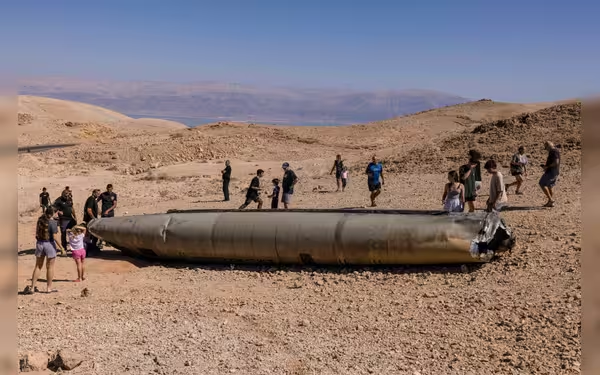Saturday, November 16, 2024 07:24 PM
Iran Missile Attacks: Lessons for Countering China's Arsenal
- Iran's missile strikes highlight defense system challenges.
- China's advanced missiles pose greater interception difficulties.
- U.S. must adapt strategies for evolving missile threats.
 Image Credits: arabnewspk
Image Credits: arabnewspkThe recent Iranian missile attacks reveal critical lessons for U.S. defense strategies against China's advanced missile capabilities.
In recent weeks, the world has witnessed a significant escalation in missile attacks, particularly with Iran launching a barrage against Israel. This event has raised critical questions about missile defense systems and their effectiveness, especially in the context of a potential conflict in the Indo-Pacific region involving China. Analysts are now examining the implications of these attacks, drawing parallels and contrasts between the capabilities of Iran and China.
Iran's missile strikes, which have included nearly 400 missiles this year alone, provide valuable insights into the challenges faced by missile defense systems. The United States and its allies are particularly interested in understanding how these attacks can inform their strategies against China's advanced missile arsenal. Experts suggest that while the scenarios differ significantly, the lessons learned from Iran's missile capabilities could be crucial for future defense planning.
One of the key takeaways from the recent missile attacks is the realization that intercepting Chinese missiles may prove to be more challenging than dealing with those from Iran. Collin Koh, an analyst at the S. Rajaratnam School of International Studies, emphasizes that relying solely on deterrence through effective defenses may no longer be sufficient. Instead, he suggests that a strategy of deterrence by punishment might need to be adopted to effectively counter a mass missile attack.
Geographically, the Indo-Pacific region presents unique challenges. The vast distances involved, coupled with China's advanced missile technology, including maneuvering warheads and precision guidance, complicate the defense landscape. Unlike the relatively compact Middle East, where missile strikes can be more easily managed, the Indo-Pacific's sprawling geography makes coordinated attacks more difficult.
In response to these challenges, the United States has been proactive in enhancing its missile defense capabilities in the region. This includes the deployment of new weapons such as the AIM-174B air-to-air missile and the Typhon missile battery in the Philippines, which can launch advanced missiles like the SM-6 and Tomahawk. However, the effectiveness of these systems against China's missile arsenal remains a topic of debate.
Furthermore, understanding the performance of both offensive and defensive systems is crucial. Ankit Panda from the Carnegie Endowment for International Peace points out that any military force planning long-range missile strikes must consider the potential impact of missile defenses. Without clear information on how well a missile defense system can perform, there is a risk of escalating conflicts unnecessarily.
Israel's layered air and missile defense systems, which include the Arrow and Iron Dome, are tailored to counter specific threats from Iran. In contrast, the United States and its allies rely on systems like the Lockheed Martin and Raytheon Patriot, THAAD, and sea-based Aegis systems. The effectiveness of these systems against China's DF-26 and DF-21 missiles, which can reach most U.S. and allied targets in the region, is a pressing concern.
While Iran's missiles may be theoretically more accurate, they are shorter-ranged compared to China's capabilities. The Pentagon estimates that China possesses several hundred DF-26 missiles, which can reach critical U.S. military facilities in Guam. This stark difference in missile capabilities highlights the need for a comprehensive approach to missile defense in the Indo-Pacific.
The lessons learned from Iran's missile attacks serve as a wake-up call for the United States and its allies. As the threat landscape evolves, it is imperative to adapt and enhance missile defense strategies to effectively counter advanced arsenals like those of China. The complexities of modern warfare demand a multifaceted approach, combining deterrence, defense, and a clear understanding of the capabilities and limitations of missile systems. Only through such comprehensive strategies can nations hope to safeguard their interests in an increasingly volatile global environment.













